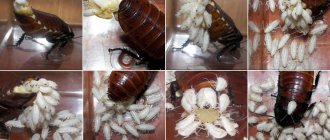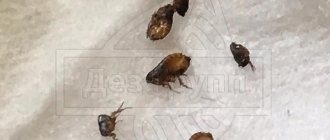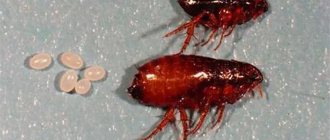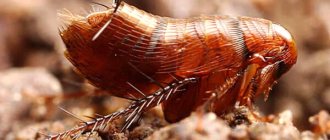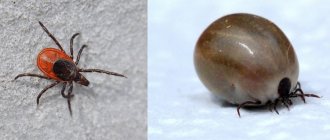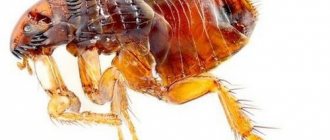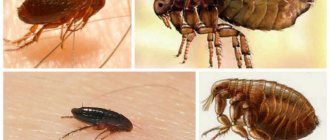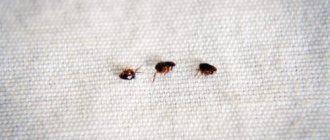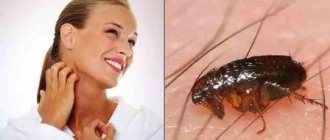If fleas have appeared in your house, and you have already armed yourself with various means of combating them, then cool down your ardor and find out more about your enemy. Knowledge is power! So, the flea, if left undisturbed, of course, multiplies quickly and in huge quantities. Moreover, fleas are animals with complete transformation. This means that the larva that emerges from the egg will be radically different from its parents. It will have different taste preferences, different sizes and different appearances. And this greatly helps parasites, because with such development the intraspecific struggle for survival is reduced to a minimum. This means the flea population can reach incredible proportions.
The processes of flea reproduction are often hidden from human eyes. However, if you still have the necessary knowledge and observe this, you can discover many interesting, and most importantly, useful nuances. It is important to know that flea bites on human skin are different from the bites of other insects.
Flea reproduction processes are often hidden from human eyes
Flea lifestyle
Since the main and only food of adult fleas is fresh blood, for development and reproduction they need to live next to warm-blooded creatures, that is, animals or people. Most parasites choose mammals as hosts, whose life is associated with the presence of a hole or home, regardless of the time of year (including pets). Animals that use shelter only occasionally are much less likely to become victims of bloodsuckers.
Pets
Fleas rarely spend all their time on the host's body. In the house they usually settle in the bedding, and periodically jump on the victim to drink blood. Only a few types of fleas are constantly on the victim's body. This is due to the fact that such parasites need regular nutrition, and after jumping off an animal, they run the risk of not finding another host.
For reference! Bat fleas can only infest bats. All other parasites are not so limited; they can easily change hosts in search of fresh blood.
Fleas in cats and dogs
Most often, a flea settles where it feels most safe. Its dwellings are garbage cans, carpets, baseboards, underground floors, animal beds and beds, and in private houses there are earthen rocks under the foundation layer, from where the flea comes out to feed on people.
To protect yourself, you need to frequently carry out wet general cleaning in the house, since a new generation of fleas, which have not yet had time to grow into adults, is also carried out into the street with the garbage. Try to treat the floors, beds of cats, dogs and cats with insecticides as often as possible, carry out such cleanings every two to three weeks in order to destroy that part of the pupae that somehow survived after the first cleanings.
Note that the cat flea is slightly different from the human flea. And what exactly you can find out from this article.
Fleas reproduce very quickly
Life cycle of a flea
During its life, a flea goes through four stages of development:
- egg;
- larva;
- chrysalis;
- adult.
Each stage is characterized by a certain appearance and lifestyle of the insect.
Egg
Flea eggs look like grains of rice - they are elongated, whitish, and translucent. Their size is about 1 mm, so it is almost impossible to notice the eggs by chance with the naked eye. It is also impossible to detect a scattering of eggs. This is due to the peculiarities of the laying process. Individual flea eggs can only be detected if you specifically examine a pet's fur if you suspect it has fleas.
The incubation period depends on environmental conditions and can range from 2 days to 2 weeks. After this, the larva hatches from the laid eggs.
Larva
The flea larva looks like a small light-colored worm. The body is translucent, with a dark spot inside. This is the esophagus in which eaten food accumulates. The whole body is covered with villi that help it move.
At first, the body size of the larvae does not exceed 1 mm, but after 2-3 days, future fleas begin to actively feed and grow. Adult fleas are partly the food suppliers for the larvae, since their excrement constitutes a significant part of the diet of the developing individual. In addition, the diet includes dried blood, particles of dead epithelium and plants, and dust. The rate of development of flea larvae, like eggs, largely depends on temperature and humidity.
Larva
Flea larvae experience 3 molts, after each of which they increase in size. This process takes up to several weeks, after which the larva pupates.
Doll
The larva finds a secluded place, gets rid of the upper layer of the epidermis, and forms a strong cocoon that protects it from external influences. The flea pupa looks like a small speck of inconspicuous gray color. Its size is about 4 mm. The transformation of a larva into an adult insect can take from 2-3 weeks to 1 year.
Research shows that if external conditions are unfavorable, a flea can linger in a shelter and come out only after smelling blood.
Adult (imago)
The imago or adult is the final stage of the flea development cycle. The size of the parasites, depending on the species, ranges from 1 to 5 mm, color from yellow-red to black. At first, the chitinous shell that covers the insect’s body is not as durable and is a little lighter. But very soon the shell becomes stronger and darkens.
The flea's body is elongated, flattened on the sides and covered with villi and spines. This helps the insect penetrate the thick fur of animals, hold onto it and move around in it. Fleas do not have wings, but have three pairs of legs, with the hind legs being much longer. Pushing off with its hind legs, the insect makes jumps that exceed its size by more than 100 times.
The mouthparts of fleas are piercing-sucking. The insect pierces the skin and sucks out blood. Parasites have very poor vision, but this is compensated by a good sense of smell. In addition, there is a special sensory organ on the abdomen that detects even the most insignificant air vibrations.
How fleas reproduce in carpets
Where do flea eggs accumulate?
Up to 80% of all fleas in an apartment live and breed in carpets. Only adult individuals live on the body of the host (cats, dogs) and lead a parasitic lifestyle. The remaining stages of fleas: eggs, larvae and pupae live in the external environment - in apartments this is primarily carpets. Flea eggs laid in the fur of cats or dogs are initially wet and sticky, but then quickly dry out and fall off.
They fall where animals spend their time: eating, lying and sleeping. Only those flea eggs survive that fall into protected areas with a warm, humid microclimate. Up to 85% of domestic fleas undergo development stages in carpets.
Why flea larvae love carpets
- The dense structure of the carpet pile surface blocks the penetration of air and sunlight, which creates comfortable conditions for the growth of larvae
- The base of the carpet fibers maintains constant humidity and temperature
- Insecticides and vacuum cleaner draft, as a rule, also do not penetrate deep into the carpet, and flea larvae develop safely
- The excrement of adult fleas accumulates in the pile, which the larvae feed on.
How cocoons protect fleas in the pupal stage
- Before pupation begins, the larva finds a secluded, safe place
- The walls of the cocoon form a barrier to protect against aggressive external influences
- The sticky silk of the cocoon collects surrounding particles accumulated in the carpet pile and becomes invisible
- During the formation of cocoons, silk fibers are tightly intertwined with carpet fibers, and it is extremely difficult to remove them from there with a vacuum cleaner.
- In addition to carpets, dolls also live in pet bedding, furniture upholstery and sofa cushion covers.
Features of reproduction
Fleas breed in both summer and winter. But for some species of fleas, the breeding season occurs only in the warm season. Low air temperatures and lack of food can interfere with the process. To successfully reproduce, fleas must be well fed.
During sexual intercourse, the female climbs onto the male’s back and pulls his sexual claw, which extends from the testes, into the spermatic receptacle. The seed moves into the female’s body in about 10–15 minutes, and the mating process can last several hours.
About two days after fertilization, the flea begins to lay eggs. How many eggs a flea lays at a time depends on the individual. Usually the number of eggs in one clutch is from 4 to 10 pieces.
The process of laying eggs in fleas occurs in a unique way. The female forcefully shoots a portion of eggs from her abdomen, and they scatter in different directions, and the insect can do this anywhere, for example, while on a cat or dog. This method allows you to save most of the offspring, since competition between larvae hatched from eggs located far from each other is initially reduced.
There is no difference in how different types of fleas reproduce; cat fleas do it in the same way as dog or earthen fleas.
Insect habitats
Fleas do not live on the animal itself. Insects prefer to settle next to a potential breadwinner: in caves, nests and burrows of animals and birds. This is necessary in order to have free access to food and drink blood at any time.
It is much easier for insects to survive in an apartment or residential building. Their habitats may be:
- bedding and resting places for pets (houses, mattresses, baskets),
- floor cracks, baseboards and carpets,
- bed sheets,
- deposits of clothes,
- furniture, bed mattresses,
- storage areas for vegetables or garbage.
The eggs fall to the floor directly from the animal, so they can end up anywhere, but the most common habitats are those that are closer to the owner - the bed and carpets.
Reproduction rate
If your house or apartment is attacked by fleas, to successfully fight them it is important to know how quickly they reproduce. Under optimal conditions, the complete life cycle of a flea from egg to adult is 10–14 days.
Life cycle
Thus, the reproduction of fleas in domestic cats and dogs living in comfortable conditions occurs very quickly, generations change every two weeks. For stray animals, the period can be much longer, since they live on the street, which means the parasites find themselves in different conditions (including temperature) depending on the time of year.
Flea eggs: description
Flea eggs are small in size, similar to grains of salt, and white in color. They develop at high temperatures in just a few days. Under normal conditions, from a week to two. Optimal conditions for flea larvae are temperatures between 20 and 27 degrees Celsius and humidity around 65%. In any other state of the external environment, fleas tend to fall into a kind of suspended animation. Therefore, their development can last from several days to several years.
The same thing happens with pupae, which, unlike eggs, can withstand lower temperatures. However, they love warmth, and can also spend several years in a state of development if conditions are unfavorable.
In fact, flea reproduction can occur without animals. If there is a male flea and a female flea in your house, then they can produce “children” even in the absence of cats, dogs and other living creatures. Fleas also do not have a breeding season. They mate when the male finds a female, or vice versa. This can happen at any time of the year.
The process of egg maturation occurs directly in the flea's body.
Lifespan of fleas
The lifespan of a flea varies from 1-2 months to 2 years. The duration very much depends on the living conditions and the species of a particular individual. High temperatures negatively affect the condition of the insect; it literally dries out. At an ambient temperature above +30⁰C, a flea will live almost half as long as at its normal temperature. Cold, on the contrary, increases the life expectancy of the parasite, as its development slows down.
The overall lifespan of the insect is significantly influenced by the period that the flea remains in the pupal stage. It can range from several weeks to a year. Even if the parasite is fully mature, it can remain in the cocoon for some time, waiting for the most opportune moment to emerge.
Fleas can live for several months without a host. They fall into a state similar to suspended animation, become less active and stop reproducing.
Stages of transformation of a flea into an adult insect
The offspring produced by the female will go through several stages of development before they become sexually mature and ready for reproduction. Ectoparasites that live in the fur of domestic animals go through the following cycle of several stages:
- egg stage;
- larval stage;
- pupal stage;
- imago.
From a biological point of view, the most difficult stage is the transformation from an egg into a viable larva. For the development of an insect, appropriate conditions are required. They can be called ideal if parasites develop in the fur of warm-blooded mammals.
Fighting methods
To kill fleas, folk remedies and professional preparations are used. It all depends on the degree of infection of the room or animal.
Methods for destroying eggs and larvae
Destruction of eggs
To exterminate the flea population, temperature is used. You can kill eggs by freezing them or washing them at high temperatures. Flea eggs are not afraid of the action of insecticides. Pests are destroyed immediately after they are born. Since the larvae do not have time to complete the full development cycle, the parasite population dies.
On a note!
It is necessary to wash your pet's rug at a high temperature, or take it out into the cold, dry it thoroughly, and leave it for two days. You can sprinkle snow on top to increase efficiency.
Fighting larvae
You can get rid of it with powder or dust. In places of detection or probable accumulation, sprinkle paths with boric acid, treat the surface with Mashenka chalk and Clean House dust. The poison enters the body through contact. The destruction of parasites occurs in 10 days. The poison remains active on the surface for about 2 months.
Flea reproduction: what eggs, larvae and pupae look like
It is almost impossible to detect flea eggs with the naked eye. If you look at them through a microscope, they resemble small white specks. Each egg is no more than 1 mm in size.
It will not be possible to find the entire clutch in any specific place on the pet’s body, since the female scatters the eggs. Future offspring are found not only in animal fur, but also on any other surface that the female brings it to.
The larvae look like small light worms that reach 4-5 mm in length. Inside the translucent body of the larva a dark esophagus is visible. The larvae move independently, making the same movements as worms.
As soon as the molting ends, the larva spins a cocoon around itself. At first glance, the doll is not much different from a grain or a particle of tissue. It takes several days for an adult flea to emerge from the cocoon.
At first, the imago has a weak, loose body resembling a light brown shell. Over time, the flea's body becomes stronger and darker. The adult individual, having acquired a dark brown color, remains so until the end of its life cycle.
